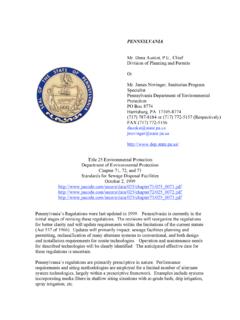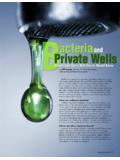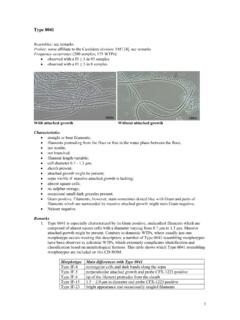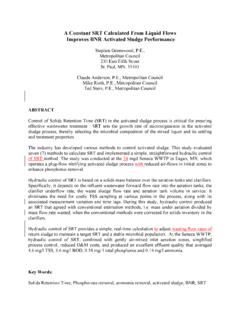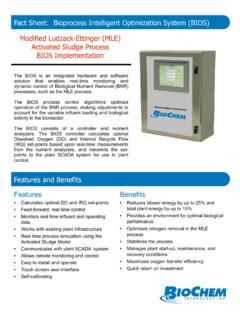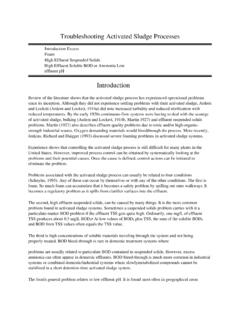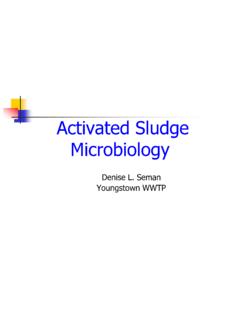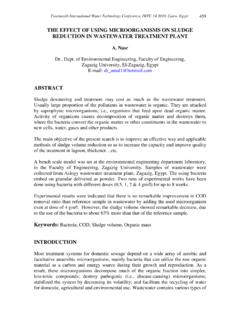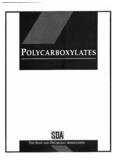Transcription of Explaining the Activated Sludge Process
1 T is to everyone s advan-tage for a community tobe able to treat itswastewater in the mosteconomical way. The activatedsludge Process has the advantage ofproducing a high quality effluent fora reasonable operating and mainte-nance costs. The Activated Sludge Process usesmicroorganisms to feed on organiccontaminants in wastewater, produc-ing a high-quality effluent. The basicprinciple behind all Activated sludgeprocesses is that as microorganismsgrow, they form particles that clumptogether. These particles (floc) areallowed to settle to the bottom of thetank, leaving a relatively clear liquidfree of organic material and suspend-ed simply, screened waste-water is mixed with varying amountsof recycled liquid containing a highproportion of organisms taken from asecondary clarifying tank, and itbecomes a product called mixedliquor.
2 This mixture is stirred andinjected with large quantities of air,to provide oxygen and keep solids insuspension. After a period of time,mixed liquor flows to a clarifierwhere it is allowed to settle. A por-tion of the bacteria is removed as itsettles, and the partially cleanedwater flows on for further resulting settled solids, the acti-vated Sludge ,are returned to the firsttank to begin the Process developed in England in theearly 1900s, the Activated sludgeprocess did not become widespreadin the until the 1940s. Today anumber of variations of the basicprocess have been developed.
3 Thisissue of Pipeline includes descrip-tions of three of the most commonvariations: Extended aeration,sequencing batch reactors, and oxida-tion ditches. A glossary of terms canbe found on page Activated Sludge plant is themost popular biological treatmentprocess for larger installations orSpring 2003 Vol. 14, No. 2 Small Community Wastewater Issues Explained to the PublicIExplaining the Activated Sludge ProcessActivated Sludge package plant at Mason Dixon Elementary School in Monongalia County, West by Ed Winant2small package plants beingused today.
4 These plants arecapable of producing a highquality effluent for the advantages of theactivated Sludge Process arethe low construction costand the relatively small Activated Sludge processis widely used by largecities and communitieswhere large volumes ofwastewater must be highlytreated Sludge processplants are good choices toofor isolated facilities, suchas hospitals or hotels, clus-ter situations, subdivisions,and small processA basic Activated sludgeprocess consists of severalinterrelated components: An aeration tank where thebiological reactions occur An aeration source thatprovides oxygen and mixing A tank, known as the clari-fier, where the solids settleand are separated fromtreated wastewater A means of collecting thesolids either to return themto the aeration tank, (returnactivated Sludge [RAS]), orto remove them from theprocess (waste activatedsludge [WAS]).
5 Aerobic bacteria thrive asthey travel through the aera-tion tank. They multiplyrapidly with sufficient foodand oxygen. By the time thewaste reaches the end of thetank (between four to eighthours), the bacteria has usedmost of the organic matterto produce new organisms settle to thebottom of the clarifier tank,separating from the clearerwater. This Sludge is pumped back tothe aeration tank where it is mixedwith the incoming wastewater orremoved from the system as excess,a Process called wasting. The rela-tively clear liquid above the Sludge ,the supernatant, is sent on for furthertreatment as required.
6 See Figure 1on page characteristicsBy analyzing the different character-istics of the Activated Sludge or thesludge quality, plant operators areable to monitor how effective thetreatment plant s Process is. Efficientoperation is ensured by keepingaccurate, up-to-date records; routine-ly evaluating operating and laborato-ry data; and troubleshooting, to solveproblems before they become seri-ous. A wide range of laboratory andvisual and physical test methods arerecommended. Principally, theseinclude floc and settleability per-formance using a jar test, microscop-ic identification of the predominanttypes of bacteria, and analysis of var-ious chemical treatment environment directlyaffects microorganisms.
7 Changes infood, dissolved oxygen, temperature,pH, total dissolved solids, Sludge age, Activated SludgeSafety considerations Practice careful personalcleanliness Require hard hats, boots, andgloves Ventilate all covered tanks Prohibit smoking around the plant Consider empty tanks as enclosedspaces and apply the proper entryprocedures Keep all hatches closed andsecured Keep tank areas well lighted Keep walkways clear to preventfalling Provide lockout protection for allelectrical equipment, gates orvalves when working in emptytanksGlossaryPIPELINE Spring 2003; , No.
8 2 National Small Flows Clearinghouse (800) 624-8301 or (304) 293-4191 Activated Sludge Sludge particles producedin wastewater by the growth of organisms inaeration tanks. The term Activated comesfrom the fact that the particles teem with bac-teria, fungi, and protozoa. Activated Sludge isdifferent from primary Sludge in that thesludge particles contain many living organ-isms that can feed on the incoming Sludge Process a biologicalwastewater treatment Process which speedsup waste decomposition. Activated Sludge isadded to wastewater, and the mixture is aerat-ed and agitated.
9 After a certain amount oftime, the Activated Sludge is allowed to settleout by sedimentation and is disposed of(wasted) or reused (returned to the aerationtank)Aerobic a condition where oxygen is presentBOD biological oxygen demand. Measure ofoxygen organic material in the water Sludge that forms clouds in the sec-ondary clarifiers when the Sludge does notsettle properly, usually caused by filamentousbacteriaF:M food to microbe ratioFloc clumps of bacteria Flocculation agitating wastewater to inducethe small, suspended particles to bunchtogether into heavier particles (floc)
10 And a quantity of material added to theprocess at one timeMLSS mixed-liquor suspended solidsMLVSS volatile mixed-liquor suspendedsolidsMixed liquor Activated Sludge mixed withraw wastewaterPackage plant pre-manufactured treatmentfacility small communities or individual prop-erties use to treat wastewaterSRT solids retention timeSludge the solids that settle out during theprocessSupernatant the liquid that is removed fromsettled Sludge . It commonly refers to the liquidbetween the Sludge on the bottom and thescum on the total suspended solidsWasting removing excess microorganismsfrom the system3presence of toxins, and other factorscreate a dynamic environment for thetreatment organisms.

